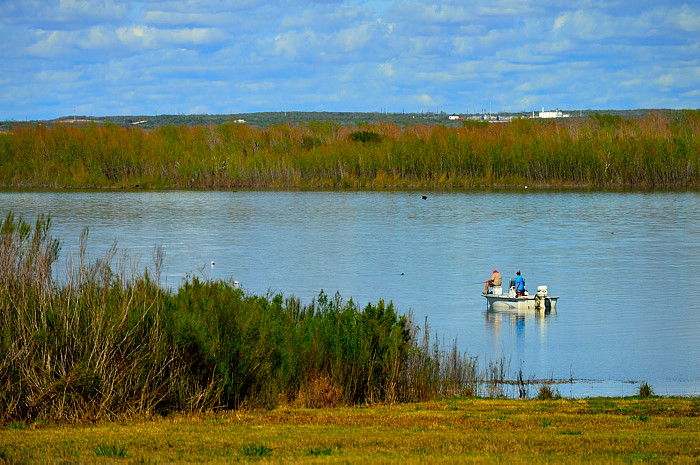Most state parks overwhelm you with warning signs, so they’re easy to ignore; this one isn’t: “BEWARE ALLIGATORS EXIST IN THIS PARK.” As you pick your way along the reed-filled shoreline, this sign grabs your attention—especially if you have a toddler or a dog. Turns out you are in the westernmost stomping grounds of the American Alligator. Local experience says you wouldn’t see a lot of alligators in Choke Canyon State Park but the few you might see could be relatively large. Fact is, one Braxton Bielski, 18 years old, was on his first public alligator hunt with his father in 2013 when he bagged his own 800-pound, 14-foot, 3-inch reptile. Though not the largest captured in Texas—that’s still one big-assed gator!

But if you are considering someplace new to get away this season, don’t be put off by an occasional oversize predatory reptile. Choke Canyon is not Jurassic Park and is less than 3 hours down the road (from Bastrop) just outside of Three Rivers, Texas, between San Antonio and Corpus. Once you experience the solitude, cool green grass and vastness of the reservoir you won’t want to leave. It’s tough to beat a shimmering sunrise over the water or the variety of wildlife that lives here (how could you not see that coming?). And if boating and fishing are your thing . . . well . . . you may be singing hymns by sunset in a body glorified—this is about as good as it gets! In fact, Choke is among Texas’ best big bass lakes and perhaps, according to some, the best bass fishing secret in the country.

A word to the wise: this place can be a little confusing. Choke Canyon State Park is comprised of two units: South Shore (day use only—boating, fishing, birding and picnicking) and Calliham (full-service park on the north side of the reservoir). About 3.5 miles outside of Three Rivers along state highway 72, you will hit the South shore portion first—facilities are sparse, it’s basically a boat dock, wetlands and a whole lot of water. Continuing on north another 8 miles, you will see the entrance to Calliham. At 1,100 acres, this is “the park” as most people know it. If you are staying in the park, remember it’s a busy place; be sure to make reservations. The park is built on the Choke Canyon Reservoir, a 26,000 acre lake which supplies Corpus Christie with water, and is set inside the James E. Daughtrey Wildlife Management Area.

Water has been a staple of life for eons and it attracts more than alligators. Paleo Indian people are known to have used the area while hunting bison and mammoth over 10,000 years ago and archeological evidence shows that nomadic hunters and gatherers lived here even after all the big game were gone. As the white man emerged on scene, rich natural resources soon began to draw more settlers; ranching eventually became the dominant industry. After the reservoir was established many diverse interests became intertwined. In 1981 the state of Texas negotiated acquisition of the land for a park on a 30-year agreement among the Bureau of Reclamation, the Nueces River Authority and the city of Corpus Christie. Even today, conservation and recreation remains the focus.
The surrounding brush country used to be home to free-range longhorns and legends of hard-riding Texas Rangers. Today the land sprawls wide and flat with wind-scoured towns and random ranches scattered about like gravel. The people who live here are of the land, their attitudes based on shared experiences and a community of burden. Three Rivers is where the Atascosa, Frio and Nueces rivers converge and it’s one of those iconic small town Texas experiences that, like authentic barbeque, is becoming a favorite bucket list item for tourists. The place has what every self-respecting Texas town requires: an old fashioned movie theater, a locally-owned grocery, a well-manicured city park and a Dairy Queen. There’s also a bar, gas station and a bait shop—everything one needs to live a long and meaningful life! Walk into any local restaurant and you’re likely to run into a group of old men holding court in a favorite corner. People talk to you here—they want to know who you are, where you come from, what kind of pickup you drive . . . stuff like that.
The Calliham unit has more amenities than most good-sized cities. You have a sports complex area with dining hall & kitchen, large indoor gymnasium with hardwood floor & bleachers and a stage with projection screen & P.A. system. Right outside are basketball and tennis courts, swimming pool and playground. Of course there are camping facilities, air-conditioned screen shelters, a boat dock, fish cleaning station and a rock jetty from which you can concoct your next fish story. Hiking trails, however, are minimal and uninspiring. For my family, it’s the RV campsites which are the big draw. Each site is spacious, carpeted with velvety green grass and protected by natural enclosures of mesquite and black bush acacia. Everyone gets the cool breezes from the nearby lake. It’s an ideal place to kick back, unplug, catch up on some reading and enjoy the solitude. Nobody will find you here—I promise! It’s not just an escape, it’s a total out-of-body tranquility experience.

Because of the location, birding is a popular pastime at Choke Canyon State Park. In fact, the park itself is a joint project between the Bureau of Reclamation and the American Birding Association. The park is mostly eroded, gently rolling brush land crossed by silted stream valleys. The sprawling lake, combined with the adjacent  upland habitat, attracts all kinds of birds in large numbers and varied species. It’s formally part of the Brush Country Loop of the Great Texas
upland habitat, attracts all kinds of birds in large numbers and varied species. It’s formally part of the Brush Country Loop of the Great Texas  Coastal Birding Trail and is especially favored by birds of Mexico. You might even be surprised by a wild turkey crossing the road in front of you during daylight hours. Most of the other animal spirits, however, show up at dusk and beyond. At the suggestion of darkness, the balance of power begins to change. When the air goes rich with butter-colored sunlight, people are no longer in charge.
Coastal Birding Trail and is especially favored by birds of Mexico. You might even be surprised by a wild turkey crossing the road in front of you during daylight hours. Most of the other animal spirits, however, show up at dusk and beyond. At the suggestion of darkness, the balance of power begins to change. When the air goes rich with butter-colored sunlight, people are no longer in charge.
I was lounging around, minding my own business and failed to notice impending sunset. Then I looked up and there they were—tight as ticks—a small family of javelinas moving through our campsite like ticket takers on a commuter train. Campers are notoriously careless with their food and trash, so these rapacious little porkers were out doing their nightly shopping. Having a better sense of smell than eyesight, they stumble right up on you like Mr. McGoo. To discourage any property disputes . . . I put up our dog and went inside. Half a minute later they vanished like a shout in the darkness.

Another sign at the headquarters warns people not to feed the raccoons. Raccoons? What raccoons? When the sun goes red and dark finally settles in, the term “organized crime” takes on new meaning. During the day, these masked pirates hide out in the surrounding scrub. But under the cover of darkness, they strike camp sites in decisive guerrilla raids, like Geronimo. The practiced little bandits are smart, efficient and have all the ethics of tomb robbers! Our outdoor ice cooler with sandwich fixin’s and condiments was completely stripped with all the skill of a museum heist (never heard a thing). Next morning it looked like a land mine had gone off outside our RV. The debris field trailed all the way into the brush line and beyond. Sandwich bags, aluminum foil and egg shells strewn about like confetti—they even devoured our onions. Only ketchup and mustard bottles survived, everything else was history. What a gluttonous orgy it must have been!
So, if you like getting up personal with wildlife, checking that special bird off your lifetime list, spending the day chasing that elusive bass or simply slipping the bounds of the working world for a weekend, Choke may just be the ticket for you. Choke Canyon is no Garner or Palo Duro—but that’s one of its main draws. Once you show up, it’s like some secret club that only certain regulars know about, cloistered in the badlands of south Texas, far away from the swarming crowds of casual tourists. With a magnificent sweep of stars at night like glass on blacktop, it’s hard to imagine a better place to relax. It’s one of my favorite parks in the entire TPWD system. I do, however, suggest you pay close attention to the warning signs. Despite inferences of over-lawyering, consider the signs helpful hints on how to make the most of your holiday. But, just for the record . . . I never saw a single alligator!
like some secret club that only certain regulars know about, cloistered in the badlands of south Texas, far away from the swarming crowds of casual tourists. With a magnificent sweep of stars at night like glass on blacktop, it’s hard to imagine a better place to relax. It’s one of my favorite parks in the entire TPWD system. I do, however, suggest you pay close attention to the warning signs. Despite inferences of over-lawyering, consider the signs helpful hints on how to make the most of your holiday. But, just for the record . . . I never saw a single alligator!


